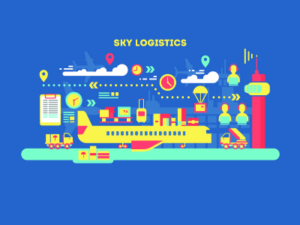The role of aviation logistics and its future
The aviation industry in China has been rapidly changing as the national economy rapidly rises. Jeff Cai, the South China general manager at Best Services International Freight Ltd, reveals the secret behind China’s economic rise and more specifically the country’s success in the aviation logistics industry.
Transportation traditionally plays a critical role in boosting a country’s development, as almost all trading activities rely upon it. Since China has come into its own as an economic superpower, its logistics industries have been developing rapidly as trade has accelerated. The rise of international trade and the rapidly increasing pace of development in the logistics industry, have served to complement each other nicely. International trade demands that growth in the logistics marketplace accelerate, and for the industry as a whole to become more cost effective. China’s existing infrastructure is one of the key secrets that makes China important in today’s international trade regime and a leader in e-commerce.
The status quo of the aviation logistics industry in China
There is currently fierce market competition and increased integration in the aviation logistics marketplace. China, having the advantage of a reduced total cost in their supply chain, a unique transportation speed and a low surcharge on goods with high safety standards, operates an aviation logistics industry that has become the envy of countries around the world.
The optimisation of air freight products in terms of quantity and quality
China became the world’s number one trader of goods, starting in 2013. Both China’s imports and exports maintained steady growth, totalling US dollars 4.16 trillion (tn), an increase of 7.6 per cent, due to dramatically increased demand in the air cargo market. According to data collected by iiMedia Research, revenue collected from cross-border e-commerce transactions have reached upwards of Chinese renminbi-yuan (CNY) 6.3tn in 2016, showing an increase of 23.5 per cent from 2015. These staggering amounts are only expected to go up in 2017, with estimates putting revenue at CNY 7.5tn by the end of the year.[1]
The development of cross-border e-commerce has actually enhanced the demand for airfreight business, with the number of air freight commodities having increased dramatically this past decade. Airfreight products have replaced many singular industrial manufactured goods like toys and textile products. This has led to an increase in high-tech and high value-added goods such as electronics and medical products.
Chinese aviation logistics turnover reaches second in the world
With continuous infrastructure improvement in the aviation logistics industry, the circular flow of income in China has now been ranked second in the world. In 2014, the national air cargo volume was 5.128 million (m) tons, an increase of 2.1 per cent, of which international air routes accounted for 1.843m tons. International flights were down 1.7 per cent from 2013, while domestic flights had increased by 3.1 per cent, and circulated approximately 3.285m tons. The national airport cargo throughput reached 98.3 per cent, with the main airports that load cargo being located in Beijing, Shanghai and Guangzhou. All of these cities contributed 49.6 per cent of the total cargo throughput.[2] When looking at the data for regional distribution, East China had the largest amount of throughput, reaching 40.8 per cent, while the southern, northern and southwest regions of China accounted for only 24.5 per cent, 18.0 per cent and 9.6 per cent respectively. The northeast and northwest areas of China accounted for 3.5 per cent and 2.2 per cent, with the Xinjiang Uighur Autonomous Region accounting for only 1.3 per cent. In 2016, the national aviation cargo freight volume increased by 6.2 per cent compared to 2015, and reached 6.68m tons.[3] Currently, there are thousands of international air cargo agencies working in the Chinese marketplace and because of this air cargo has been on the rise. Projections show air cargo volume rising to 6.8m tons by 2020, with the average annual growth rate of express servicing exceeding 20 per cent.[4] The global aviation cargo turnover volume experienced an increase of 2.3 per cent in 2015, although that number is expected to grow to 3.5 per cent at the end of the year. Along with this increase, civil aviation airport cargo throughput is expected to grow at 7.5 per cent annually.[5]
Future development
Upstream and downstream expansion
In order to have a sustainable future for aviation logistics, companies are working on both upstream and downstream expansion. Aviation logistics will inevitably expand across the industrial supply chain, with ‘resource integration’ as a strategy drawing consensus from the industry.
Internationalisation
The aviation logistics industry has been rapidly developing throughout the Asia Pacific region. In 2013, four of the top five airlines, that have the most airfreight volume, are located in the Asia Pacific region. It is expected that as the Asia Pacific market consolidates it will become a global air cargo hub. Because of this, the aviation logistics industry in China will be increasingly internationalised and will subsequently have more opportunities made available to it.
Airports in second-tier cities
In recent years, as air cargo facilities and equipment are improved upon and with the volume of cargo steadily increasing, many airports in second-tier cities, such as Zhengzhou, Wuhan, and Nanjing, have started to expand. The collaboration of cargo transportation will be an important trend that can facilitate the sustainable development of the aviation logistic industry.
Custom clearance
In order to adapt to a regional economic development strategy, the regional clearance management process must be re-engineered, customs clearance integrated reform has been implemented in Beijing, Tianjin, the broader Hebei provincial region, the Yangtze River Economic Zone, and Guangdong Province. These areas have established a unified regional customs declaration system, a new risk-control process, improved professional examination procedures and improved on-site operations. These regional customs are able to achieve interoperability through reform and companies can choose to declare, pay taxes or clear customs in these areas in a manner convenient to them. To improve internal cooperation, customs clearance integrated reform was implemented starting in July 2017.[6] With the implementation of integrated reform, aviation logistics companies will be able to operate more effectively and efficiently.
Internet of things
It has always been essential for logistics companies to keep track of where their cargo is, and the ‘Internet of things’ has made it much easier. The industry can utilise the Internet to improve development and resolve current issues. For example, iTracing has based their software on a service (SaaS) platform which will be able to alleviate shortages in the traditional air cargo state-owned system. William Arten, the former director of the Lufthansa Cargo Group, indicated that e-commerce will revolutionise the industry, stating that the Internet will change everything.[7]
Conclusion
In conclusion, the future development of the Chinese aviation logistics industry will encounter both opportunities and challenges. Companies that are able to adapt to the future environment and take advantage of these new opportunities will be able to grow exponentially in the flourishing logistics industry and play an important role in the global market.
[1] An Analysis of China’s Cross-border E-Commerce Market in the First Half of 2017, Cifi
News, 9th August 2017, <http://www.cifnews.com/article/27996>. (in Chinese).
[2] 2016 Civil Aviation Airport Cargo and Postal Throughput Rankings, AskCI, 4th March 2017, <http://www.askci.com/news/paihang/20170304/10511592497.shtml>. (in Chinese).
[3] 2016 Analysis of China’s Aviation Transportation Operations: Cargo and Mail Traffic Volume was 6.68 Million Tons and Passenger Traffic Increased by 12%, AskCI, 4th March 2017, <http://www.askci.com/news/paihang/20170304/10511592497.shtml>. (in Chinese).
[4] Analysis on the Development Trend of China’s Air Cargo Industry in 2015, China BGao, 20th November 2015, <http://www.chinabgao.com/k/hangkonghuoyun/20769.html>. (in Chinese).
[5] Prospects for Global Aviation Market Development in 2017, CCA Online, 14th February 2017, <http://www.ccaonline.cn/hangjia/article/314061.html>. (in Chinese).
[6] General Administration of Customs to Promote the Integration of Customs Clearance Reform Across the Country, Shanghai Municipal Government Website, 2nd July 2017, <http://www.shanghai.gov.cn/nw2/nw2314/nw2315/nw4411/u21aw1240561.html>. (in Chinese).
[7] Liu, H., An Analysis on How the Internet Influences the Air Cargo Industry, Civil Aviation Resource Net, 26th December 2014, <http://news.carnoc.com/list/302/302535.html>. (in Chinese).
Best Services International Freight Ltd (BSI) group is an integrated international logistics enterprise and a full logistic solution services provider that covers international and domestic air transport, FCL, LCL, bulk cargo transport, charter service, multi-modal transport, warehouse, distribution, customs brokerage, agent for cargo insurance, import and export business. BSI is especially strong in the air, as one of the top air master co-loaders in South China, BSI signs BSA contracts with various mainstream airlines which guarantees lowest possible cost in the market, as well guaranteed space and transit time during peak season for its valuable clients. The company has an office in Shenzhen, Guangzhou and Dongguan and many other cities of China.




Recent Comments